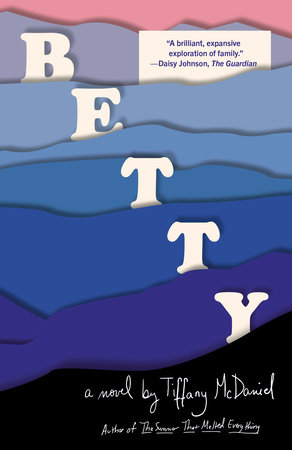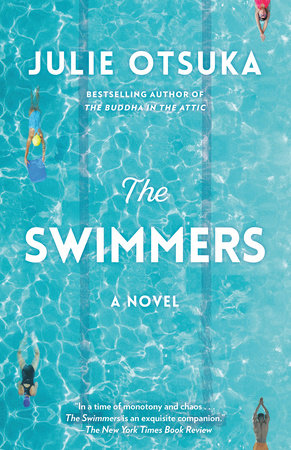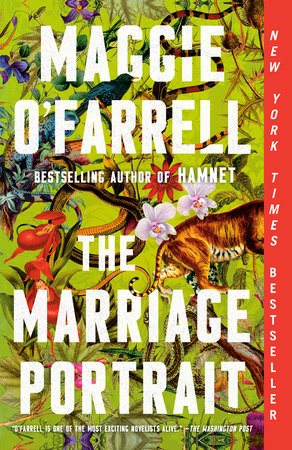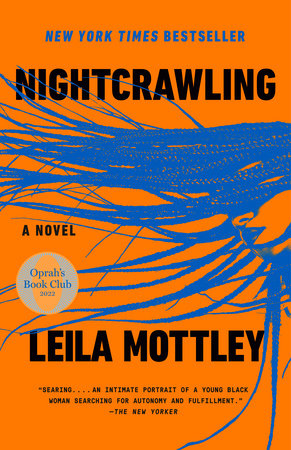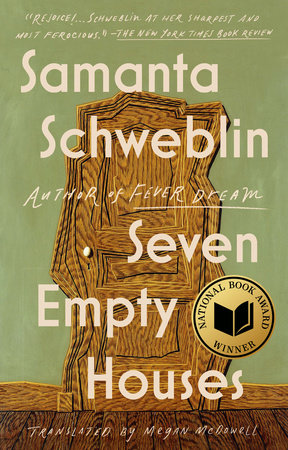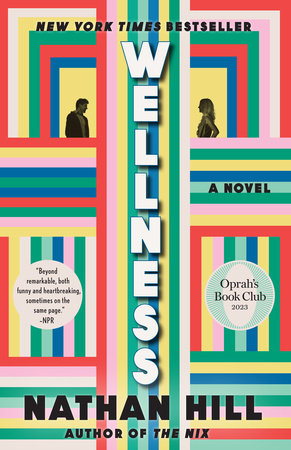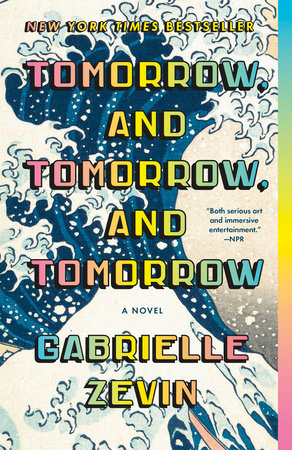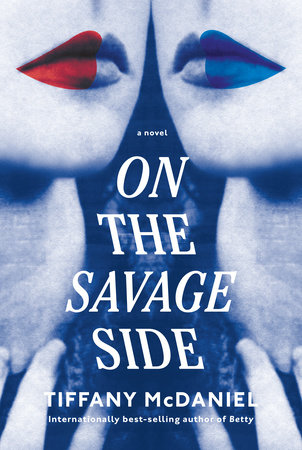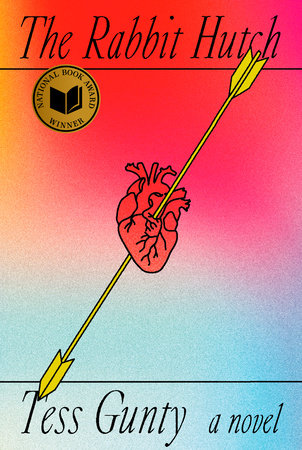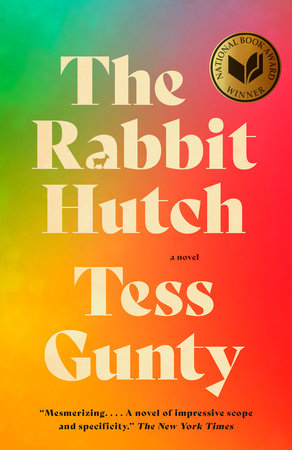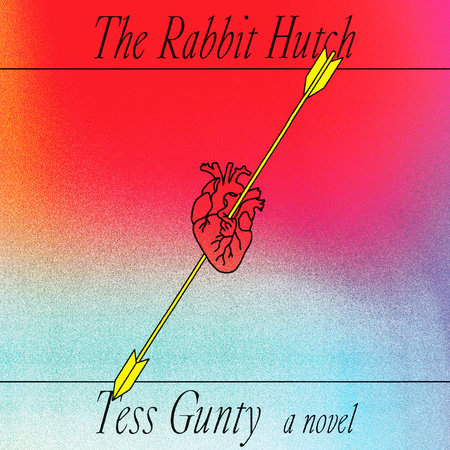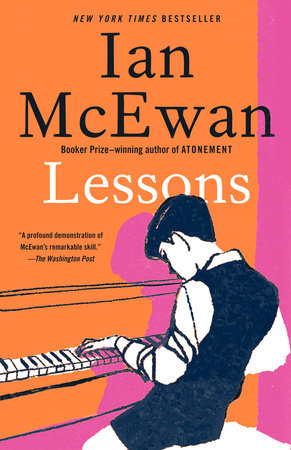Author Q&A
If we drove through Vacca Vale, Indiana—the fictional town where The Rabbit Hutch takes place—what would we see?
Snaking up the center of the city is the Vacca Vale River, now toxic. Everything is near the River, and the River is the reason for the town. Downtown Vacca Vale expands in a circle in the middle of the city. It’s filled with derelict but ornate and cakelike architecture, most of which was built in a more hopeful era. You’ll find Ampersand, the pie diner where Blandine works, near those buildings. To the north of downtown stands a neighborhood of old, magnificent mansions in various states of splendor or decay, built in the early-twentieth-century by affluent people who worked for the now-dead automobile company, Zorn. Some are vacant, some have been converted into museums, and some are occupied. To the west of those houses scatter a few gloomy businesses: the Vacca Vale cinema, a strip mall, the Wooden Lady Motel, and the Zorn Museum. To the north of the historic houses sprawls industrial farmland. The entire Northern swath of Vacca Vale has been commandeered by corn and soybean monocrops, suburbia, the town’s only private high school (which Blandine attends), and a few mega churches. Chastity Valley, our heroine’s favorite part of her city, is situated southeast of downtown. Over five hundred acres, the Valley is shaped like an arrow pointing east. Southwest of downtown is a campus of abandoned Zorn factories, now canvases for graffiti artists. Finally, the building where most of my characters live—La Lapinière, or the Rabbit Hutch—stands near those factories. The Rabbit Hutch is a repurposed building from the late nineteenth-century that once housed factory workers. The Rabbit Hutch shares a street with a small Christian church, a Christian laundromat, a Christian women’s shelter, and a convenience store.
If you were to take an aimless drive through Vacca Vale, you’d see foreclosed shops and boarded-up houses. A sports bar, a fast-food chain, a tanning salon, a thrift store, a liquor store, and a vape store. A tin-paneled shop with vacant lots on either side of it and plywood nailed to its windows. A rusty door. Vines reclaiming brick foundations.
There’s a story that Hildegard wrote in the twelfth century which Blandine quotes at some point in the novel, and I think it captures the spiritual essence of Vacca Vale. Hildegard writes that the Devil was jealous of God because God created everything. The only thing that God hadn’t yet created was nothing, so the Devil created nothing, and fell through that nothing and is falling still. I find that to be a phenomenal origin story of evil, but also a perfect description of fundamentally abandoned places like Vacca Vale. Vacca Vale may be filled with junk, vacant buildings, billboards, trash, churches, gas stations, strip malls, intersections, but the accumulation of these objects in this place evoke absence rather than presence. People are falling down the Nothing.
You were raised in South Bend, Indiana. To what extent were you thinking of South Bend while you were writing about—and building the world of—Vacca Vale?
Vacca Vale is a patchwork of the Rust Belt towns I know: Gary, Indiana; Flint, Michigan; Youngstown, Ohio. There was a powerful purgatorial sensation that would invade me as soon as I approached a town that had suffered a similar economic fate as my own, South Bend, and this novel was my effort to conjure that sensation in language. It’s like wearing cold damp clothes in the basement of a building where it is always 4 p.m. Low ceilings, beige everything. A doorless, windowless waiting room with no one at the desk and no distractions. You just have to sit on a metal chair until your name is called. When writing The Rabbit Hutch, I wanted to create an otherworldly place that wasn’t perfectly bound to the governing rules of so-called reality, a fundamentally unstable environment that summoned eccentricities, crimes, ghosts. I set the novel in a fictional city because I needed to be free of geographic likeness so that I could better evoke emotional likeness.
But Vacca Vale was, as the question suggests, predominantly modeled on South Bend, which is where I spent the first 22 years of my life. It was the place that introduced me to that purgatorial sensation, producing a supernatural familiarity with it that allowed me to detect it at once in another landscape. My hometown was a land of abandoned factories, unnatural stretches of industrial crops, signage for long-dead businesses, disposable city design, permacloud, no spring. The closest strip mall to my house had a tanning bed, a thrift store, a liquor store, a vape store, a pet store, a video store, and a Starbucks; this seems to encapsulate the coping mechanisms and needs of my abandoned community. When I was in high school, South Bend ranked on Newsweek’s list of “Top Ten Dying American Cities.” To me, this public diagnosis was almost comforting, like a confirmation of a long-suspected illness. At the very least, it gave the illness a name, gave the symptoms a cause.
Vacca Vale is what I imagine South Bend would be like if the University of Notre Dame didn’t exist. South Bend was once the home of Studebaker Automobiles, which in its heyday was the largest car manufacturing facility in America. But after reigning for nearly a hundred years, the industry closed in the 1960s. Notre Dame was already there to absorb some of the economic shock, and it quickly became the dominant employer, the primary god of town identity.
But despite Notre Dame’s existence, countless people were still left behind when the automobile industry closed; not everyone can transition from a job at a factory to one at a private university. Some families didn’t recover for generations. Many are still recovering.
Born 30 years after the fall of Studebaker, I grew up sensing that our city was haunted by its former economic glory. Rates of poverty and its attending consequences were much higher than the national average, astronomically higher than Indiana’s average. I saw evidence of these consequences every day in my neighborhood. Theft, bankruptcy, foreclosure, addiction, sexual assault, police brutality, and gun violence didn’t occur in abstract statistics—they occurred in events of horrific particularity, harming singular members of my community, bulldozing lives. While none of these stories ended up in The Rabbit Hutch (they don’t belong to me), they certainly informed the worldview of the novel. Our own house was robbed twice, our car was once towed by the bank, a close friend who lived ten feet from me suffered from varied manifestations of neglect and maltreatment, and we frequently heard shootings nearby. When I was in college, I read that a baby had been accidentally shot and killed in a drive-by just a few blocks away from my home.
In short, the violence throughout The Rabbit Hutch was inspired by the many scales and manifestations of violence I witnessed in South Bend. I wanted to trace interpersonal violence and neglect to the structural violence and neglect that engineered it. Poverty forecloses opportunities, producing tremendously pressurized communities. Our public school system consistently underperforms, and plenty of students in South Bend are never presented with a good reason to finish high school; what’s the point if you’ve never seen the degree deliver anyone you know to a better life? When people are robbed of hope, when most of the roads to pursue health and financial security are closed, when women are forced to give birth before they’re ready to due to a combination of cultural pressure and a lack of reproductive services, when chemical escape becomes more appealing than reality, violence is inevitable. This inevitability demonstrated itself over and over again in my city. In 2016, the year Trump was elected—the year I began writing The Rabbit Hutch—violent crime in South Bend increased by nearly 44% from the year before. When our mayor, Pete Buttigieg, began his campaign for presidency in 2019, headlines from far-right publications labeled South Bend as “one of the most dangerous cities in America.” These articles were intended to smear his reputation and they were filled with inaccuracies, but the headlines themselves were not sensational. (What they failed to mention was that he dramatically improved many things before he left office and that he inherited an unusually arduous job.) In 2020, rates of violent crime including assault, homicide, rape, and domestic abuse all increased; homicide alone increased by 87 per cent. In 2020, there were 1,728 violent crimes committed for every 100,000 residents in South Bend; the national average was 399.
South Bend was a place where national injustices are made personal, visible, and abundant. You can see the climate crisis, there, too—not just in the severe weather that has been wreaking havoc the industrial farmland there, but also in the city’s increased flooding. South Bend is so-named because it’s situated on the southernmost bend of the St. Joe River. Within the span of eighteen months, the town experienced a 500-year flood and a 1,000-year flood.
And then there were the stories people told me about growing up in South Bend, which were very present to me as I wrote. My father grew up outside Chicago and my mother’s family settled in Northern California, so I learned about the history of my town through other people. Throughout high school, I worked at a bread bakery, and every weekend I operated its stand at the local Farmer’s Market. There, people would stop at my booth and tell me the stories of their lives, sometimes for hours; I was honored and surprised by their trust. The voices of these people—most of whom were elderly, left behind by family and friends, failed by structures that were only beginning to become visible to me—took up residence in my mind and never left, expanding my understanding of our collective home, the infinite lives available there, the patterns detectable among them.
In college, when I read Eliot’s The Wasteland or Dante’s Divine Comedy or Thomas’s Under Milk Wood or Beckett’s Waiting for Godot, I recognized the language as though I had read it before, I felt I was reading the landscapes of my brain; these texts felt like home because I’d spent my whole life in the weather they brewed. Still, I had never seen a city like mine explicitly represented in fiction. In childhood, this seemed like a good reason to set all of my writing elsewhere. In my twenties, this seemed like a good reason to set all of my writing—unapologetically, ecstatically—in the postindustrial Midwest. Even when I tried to set a novel in a dystopic future, or New York City, I was always pulled back to a place like South Bend; it had something it needed me to say.
I now appreciate growing up in a place where the brutality of industrial appetites was visible. My high school was situated across from a dog food factory, which paused production during school hours but was active in summers, when I had soccer practice twice a day. Running 8-miles of intermittent sprints in 99-degree heat with 100 per cent humidity through the pungent odor of fish guts is an experience you never forget. (I couldn’t resist placing a dog food factory across from Blandine’s high school in the novel.) In America’s popular, pricey, coastal cities, modes of production—the machines, chemicals, and labor that facilitate our conveniences—are mostly concealed. But in so many neglected regions of this country, the Anthropocene is visible everywhere you look. In a city like South Bend, the price of industrial convenience is one you pay, and the consequences are far more hazardous than a bad smell. The cancerous chemicals of coal mines, factories, and farms are in your soil, your water, your baby, your air. The extractive economy is visibly extracting from your family, making your parents sink in debt, making your sister infertile, turning your cousins into conspiracy theorists. Your childhood friend met his wife in treatment for opioid addiction.
I put other things I loved about South Bend in The Rabbit Hutch, too: I cherished the humid summer nights, the wonky Catholic iconography, the humility, the way people really listen to each other even if one person is telling a long, bad anecdote. There’s desperation, yes, but also jagged and mesmerizing beauty. Poverty and violence collide with otherworldly splendor. Death and God are looked in the eye. Nothing is more itself than when it’s next to its opposite; blue is bluest when it’s beside orange. The devastation was especially devasting and the celestial especially celestial because these things were indivisible, the sacred was bound to the profane and the occult was bound to the ordinary. You learned to alchemize despair into humor, to seek transcendence in the pedestrian, to cultivate faith in people.
Once, when I attended a Ravel performance at the New York Philharmonic, the woman next to me—a native Manhattanite in furs—asked where I was from. I had half a draft of The Rabbit Hutch written at the time. When I replied Indiana, she gasped. I never would have guessed! she told me as if this were a compliment. You got the impression that she had never left the Upper West Side except to go to Europe; it was easy to imagine her with a judgmental Pomeranian and jewelry insurance. I didn’t know anyone was actually from Indiana! Did you turn the lights off when you left?
The Rabbit Hutch is my effort to keep the lights on after I left. Indeed, to make them brighter.
Throughout the course of the novel, we hear the voices of several tenants of the Rabbit Hutch, a run-down apartment building at the edge of town: a young mother who’s terrified of her newborn’s eyes, a widowed logger who’s taken to dating apps, an aging couple who keep finding dead mice on their balcony, a group of four teenagers who have recently aged out of the state foster care system. Whose voice came to you first? Whose voice was came to you loudest?
Joan’s voice came to me first. I was 23, I had written hundreds of labored pages that inevitably nauseated me, I was having a numinous experience with The Quick and the Dead by Joy Williams, Brooklyn was finally melting after winter, and I had just listened to a radio program that included a brief interview with a person who screened comments for an obituary website. Afterward, I couldn’t stop thinking about that job. I know I have to take an idea back to the laboratory when it starts sprouting neon mushrooms on the dirt floor of my brain. To spend your days treading in the guest books of online obituaries! What would such an occupation do to you over time? I’m usually drawn to things that contain what Joyelle McSweeney refers to as an “infernal superposition of states,” things that are “double but not binary.” As usual, it was the contrast bound within the job—the absurd and the serious, the humdrum and the supernatural, the internet and the afterlife—that I found so magnetic. After listening to the radio program, I wrote a scene in which a lonely, middle-aged obituary comment screener feels so guilty about the unthanked holiday gifts she receives from her aunt that she’s driven to donate them to a woman who lives on her street. This scene launched a five-year devotion to a Word document that would become The Rabbit Hutch.
Somehow, I’d saved enough money from my student stipend to write full-time that summer. Every morning, I’d walk to Prospect Park with a notebook and books and a five-dollar beach towel, leaving all my electronics at home.
I suspect that much of The Rabbit Hutch was a heat hallucination. In the humidity of Prospect Park, each character arrived on my psychological doorstep bearing nothing but his or her most eccentric quality, like punchlines who are missing their jokes. A man who punishes his enemies by covering himself with the liquid of broken glow sticks and breaking into their homes. A teenage girl who just aged out of the state foster system and now longs to become a mystic. Three teenage boys who find themselves sacrificing animals to express their love for her. A dying celebrity who finds it impossible to care about anyone except for the endangered Three-Toed Pygmy Sloth. A young mother terrified of her newborn’s eyes.
Jack’s voice was the strongest. In New York, I spent so much time with the collective male gaze in the archery of street harassment, I thought it would be interesting to swap perspectives and narrate from it. Because Jack’s voice was so distinct from my own, it arrived to me with ease and clarity, as though I were merely overhearing it.
The task of the next five years was to create characters who were breathing people, not jokes. To create a world where these peculiar behaviors were not only believable, but inevitable.
What were you hoping to achieve by writing a polyphonic novel and allowing a multiplicity of voices and storylines and perspectives to populate these pages?
When I began writing The Rabbit Hutch, I was reading a lot of contemporary polyphonic fiction and the structure increasingly bewitched me. At the time, I was desperately searching for a realer realism, and I found these structures much more successful at conjuring the tumultuous, choral experience of consciousness than single-perspective novels. (Obviously there are exceptions to this rule, chief among them Ferrante’s Neapolitan novels.) Instead of buckling you into a single life and driving you from point A to point B through a chronological Three Act Structure, polyphonic novels set you loose in a lush and complex ecosystem. In a good novel, every life form, no matter how small, is essential for the health of the whole. It’s up to you to listen for the resonances, to learn the mechanisms of the interdependent environment, to wander, to get lost. As works like NW, Middlemarch, Great House, A Visit from the Goon Squad, and Infinite Jest illustrate, if your protagonist is not a person—if it’s a place like Northwest London, or an object like a desk, or force like “time,” or a theme like “loneliness”—the novel often requires multiple voices. Mine is not a comprehensive portrait of Vacca Vale—no book is a comprehensive treatment of its subject, thank goodness—but I knew I’d get closer to a balanced composition if I included people of varying ages, histories, occupations, and physical differences. Each character led me by the hand and introduced me to the next.
In an interview, Nicole Krauss once said: “One life is not enough.” I often think about that when I write. Writing is a way to access other lives, and also to stage the lives abstractly playing out in the multiverses of our imaginations. Nobody is only herself. If you were to excavate my brain you’d find my three older brothers, my parents, sixty first cousins. You’d find many dramatic reenactments of the Stations of the Cross, a middle-grade novel about kids who time-travel to ancient Egypt, and a library of showtunes. You’d find my fourth-grade teacher alongside the manager of the crêperie in a small French town who opened the restaurant to relieve me and my friend from the rain. There’s the woman who died on my subway car my first Halloween in New York. She’s sitting beside Anne Carson, who’s leaning her head on the shoulder of Simone Weil, who’s accompanied by the scent of lavender bath salts that my mother keeps in the guest room where I stay when I visit. There’s the French boy with one blue eye and one green eye who was studying to be a painter, and the Bologna hostel where I met him. You’d find the great-grandmother I never met who put tacks under the tires of automobiles belonging to members of the KKK; the peach-faced, turtlenecked child on a rocky beach in Nice who repeatedly struck her own head; the 2015 production of Cymbeline in Central Park; the elderly leather-maker who operated the booth beside mine at the Farmer’s Market and often gave me butterscotch candies. You’d find Drew Barrymore in a Renaissance costume repeatedly performing the line: What else is to be concluded, sire, than that you first make thieves and then punish them? You’d find every dog, cat, goat, parakeet, rabbit, hamster, fish, and chinchilla I’ve ever loved. I don’t know how to transcribe a self without transcribing all the life that has passed through it; it’d be like trying to depict the Grand Canyon without its history of water. You and the people with whom you’ve collided aren’t the same, but you’re indivisible.
As the novel unfolds, we learn that the local government in Vacca Vale is soon to begin construction on a revitalization plan, designed to turn Vacca Vale “from a dying postindustrial city into a startup hub, attracting talent from around the world.” The developer at the helm of the project is quoted in the local paper: “Urban revitalization plans have failed countless residents in the past. But we won’t fail you.” What would failure look like for the residents of the Rabbit Hutch? Are they already failed from the start?
In 1942, Joseph Schumpeter coined the phrase “creative destruction” to describe the cycle of industry innovation and destruction, which he considered “the essential fact about capitalism.” Economically elevated and then gruffly abandoned by the automobile industry, Vacca Vale has already been failed by the cycles of creative destruction, and I think Blandine sees that the urban revitalization plan only promises another. As we’ve seen in San Francisco, the tech industry is an invasive species that tends to consume all the culture, housing, and politics within and beyond its habitat. Blandine doesn’t trust that industry, or the exclusively white male team in charge of the redevelopment. She’s especially skeptical of the head developer, who has never lived in the Midwest but has made a name for himself revitalizing Rust Belt towns.
I actually think the developer is probably a decent leader with decent ideas, someone who prioritizes urban health over profit, and I think his plan will improve Vacca Vale overall, but it’s obvious why a person like Blandine—who has been repeatedly failed by systems and individuals, and remains fiercely devoted to Vacca Vale even though she finds it suffocating—would automatically disdain him. The plan has many targets, but the most odious, to Blandine, is Chastity Valley, the only remaining green space in Vacca Vale, and the sole place Blandine has ever considered her home. I imagined Chastity Valley as a wilder, less groomed version of Prospect Park, in which I wrote the foundation of this novel and to which I am madly attached. Blandine also knows that it is possible to redevelop underperforming/already dead areas of the city, like abandoned factories (brownfield sites), and that this would be a more ethical approach, but it’s cheaper to work from a clean slate (greenfield sites). It’s not necessary for the developers to mutilate Chastity Valley to house the tech talent they’re trying to import from coastal cities—it’s just cheaper to bulldoze trees than it is to adaptively re-use vacant buildings. That’s the most damning aspect of the plan, in Blandine’s view, and I think she’s right to oppose it. She knows that it is an urban failure to relinquish a known public good for the dangled carrot of economic growth—a reward that can never be guaranteed. So Blandine primarily wants to protect the Valley, but she takes issue with other aspects of the plan, too. She knows that “trickle down benefits” like jobs, growth, and safety seldom trickle down.
I loosely modeled this revitalization campaign off ones that are occurring in reality throughout the Rust Belt. When I was in college, Mayor Buttigieg envisioned South Bend as a potential startup hub for complex reasons involving weather and fiber optic cable, if I recall correctly, but I think he did so more ethically, converting brownfield sites like abandoned Studebaker factories and prioritizing thoughtful urban development. When I was in high school, the state of Michigan launched a campaign to attract tourists called “Pure Michigan,” and they would play these saccharine but alarmingly heartrending advertisements on the radio, voiced by Tim Allen over soft piano music, describing a distinctly Midwestern splendor, a distinctly Midwestern peace, and sometimes, as I was working my shifts at the bakery, these commercials would move me to tears. I think it’s because it described a place that I longed for but did not see. So when I was writing The Rabbit Hutch, it was important for the “Vacca Vale: Welcome Home” campaign to likewise prey upon a collective desire for community, safety, prosperity, and beauty, promising resources to strangers that the city did not deliver to its own residents.
In a previous draft, there was a long chapter I ultimately decided to cut that included a speech Blandine intends to read at a community hearing—an in-depth critique of the urban revitalization plan. She mentions that Chastity Valley is home to 493 species, all of whom would suffer from the construction, and that she is “especially disappointed by the plan’s sparse and feeble commitments to sustainability. It does not address sewage remediation that the Vacca Vale River badly needs, nor does it confront the runoff from surrounding soybean and corn farms. The nitrous oxide from these industrial operations causes algae blooms that suffocate our aquatic ecosystems. The glyphosate is causing birth defects, reproductive harm, and cancer. While I appreciate the plan’s gesture at carbon neutrality and its abstract schemes for wind farms and solar panels, these efforts are all phased for a ‘later date.’ As I understand it, this is because such labors have been deemed too costly for the first phase of construction. But the cost of inaction far exceeds the cost of action, and we have lost the privilege of short-term thinking. The development must be built to depend upon renewable resources—if it’s not, we lack the incentive to execute these measures in the future. The federal government has made it clear that it will always fail to act in time. Thus, the imperative to act falls on the shoulders of local governments. There is almost no chance that renewable energy will ever get to Vacca Vale if it isn’t incorporated now, taking advantage of the money, expertise, political will, and momentum. I remind you that, in the past five years, Vacca Vale endured a thousand-year flood and a five-hundred-year flood. The redevelopment plan does not address the river’s increasing propensity to overflow, nor does it respond to the inevitability that the American Midwest will have to produce crops to feed itself as the climate crisis renders agricultural imports unviable.”
She goes on to suggest xeriscaping and condemn logging. She censures the plan for failing to eliminate car-dependence, and points out that the proposed public transit system does not reach the low-income neighborhoods of Vacca Vale. The plan proposes no efforts to redress the food deserts and underfunded schools in those districts. She calls the tram through the Valley is “essentially decorative,” as it does not connect to the transit center downtown. There’s no outline for bus routes, and the proposed train system caters to the geographic needs and the social exclusivity of the suburban communities in the Northwest, along with the needs and preferences of the incoming tech communities who will settle in the Valley, doing little for the residents whose families have been in Vacca Vale for generations—the people that the revitalization is supposed to revitalize.
She points out that the developers quietly sold land that was previously set aside for smaller-scale, local developers to places like Walmart and Amazon and cable monopolies. She goes on to liberally quote from Sherry Arnstein’s 1969 paper “Ladder of Citizen Participation,” in which Arnstein proposes a typology that ranks eight rungs of community engagement from low-impact to high-impact actions. “I am here to request more than perfunctory engagement from your development team, Mr. Ritter. How will you extend partnership, delegation, and citizen control to the people of Vacca Vale? The theme of your campaign is home. But how can any inhabitant make herself at home in a place where she is powerless to govern her life?”
Blandine, whose story is central to the novel, desperately wants to exit her body. What exactly does that mean to her?
While Blandine is the only character who explicitly wishes to exit her body, none of my characters have a breezy time inhabiting a body, a consciousness, a world. While I do insist on the difference between me and my characters, I think in order to explain Blandine’s desire to exit her body, it’s helpful to describe my own experiences. As a child, I believed that I could leave my body in that hinterland between consciousness and sleep: I thought I could travel my city in the air, switch bodies with my pets. This seemed like a magical but achievable power. At a young age, I learned about a female mystic—maybe Thérèse de Lisieux—who transcended her body during divine ecstasy, which was described as total unity with God, and God was described as Love. “Indescribable happiness” resulted from this unity. This appealed to me enormously; I was an oversensitive child who often felt trapped in her city, house, family conflicts, financial stress, and anxiety disorder, so that kind of totalizing, ecstatic escape seemed like the only pursuit worth chasing. Later, I learned that my mother felt she had left her body on more than one occasion. Even though I’m not as persuaded by mysticism and magic as I was as a child, in moments of severe physical or psychological pain, I still find myself longing to leave my body, to flee to an existential second home until conditions improve. I believe this is a nearly inevitable condition when you’re raised in a culture that teaches you that your body is not your own.
My only rebellion as a teenager was theological. I was raised in a severely Catholic household, school system, and city. It’s hard to exaggerate its grip on my brain. Although my parents were Democrats, my father attended a high school for boys considering the priesthood and worked at retreat houses and ministry for a long time; my mother was in a convent in her twenties and claimed the nuns made her drop out because she was too loud. To this day, she references things the Virgin Mary has done or said—in recent decades, mind you—the same way she references things her sisters do and say: frankly, affectionately. There is a flourishing lore of miracles, signs, and wonders in my maternal family. Throughout childhood, I was extremely religious and often thought I’d be a mystical nun when I grew up. But by the time I was fifteen, armed with a newfound awareness of the Church’s systemic abuses, newly aware of its patriarchy, I launched into a spirited rejection of Catholicism that remains with me today. Planted in the lawn of our Catholic high school were dozens of white crosses: honorary graves of aborted fetuses. In high school, when Obama was running against McCain, the entire student body was forced to spend a homeroom period writing an essay about why it was the Catholic’s moral duty to vote for the anti-abortion candidate (most of us were too young to vote). Everyone around me sleepily scrawled the requisite three paragraphs, then spent the rest of the time on their homework. Powered by teenage rage, I wrote throughout the entire period, arguing that to be truly pro-life is to be anti-death-penalty, anti-war, anti-fossil-fuels, pro-universal-healthcare, pro-social-safety-net, intolerant of racism and welcoming to immigrants. Etc. When the bell rang, I submitted several pages of unhinged, hand-written fury. The teacher accepted my pages with a raised eyebrow. Shortly after that, Barack Obama was invited to give the commencement address at Notre Dame, prompting months of anti-abortion propaganda throughout the city, summoning protesters from far and wide. On the drive to school, my brother and I would pass an enormous billboard featuring a photograph of an aborted fetus. If you see something like that before 8 a.m. every morning, it will permanently lodge into your mind. On the day of Obama’s speech, my brother, his girlfriend, and I went to the University to protest the protesters. I still remember the way a woman’s face seemed to reach off her head as she screamed at me, the total absence of control she seemed to have over herself, as if she were possessed.
I protested the Church and its hypocrisy whenever I could with the kind of life-or-death energy you devote to ideologies when you’re young. I was ashamed of almost everything in those days, but I was never ashamed when I publicly confronted a priest about the Church’s sexism, which I did every chance I got, even when it made my peers ashamed on my behalf. When I discovered the countless ways the Church was hurting my friends—some had been abused by priests; some spurned in their communities when their parents divorced; some were rejected for their sexuality; some had to drop out of high school, suffer public humiliation, and give birth against their will because they were denied birth control first and abortion second—my rejection of the Church became absolute. I explained this rejection to my parents, but they continued to force me to attended church every Sunday, so I stopped accepting communion. Once, I tried to stay in the vestibule of the church, but my father threatened me, and that’s when I knew that my parents’ insistence on my Catholicism wasn’t just about faith; it was an assertion of their dominance over my body and mind. Naturally, this made me double-down.
I’m sure the sense of entrapment rattling throughout The Rabbit Hutch came from the cage of conservative, Midwestern, patriarchal Catholicism I felt myself to be locked inside. But I now see that that the embodied urgency that Blandine devotes to ideas is also something she inherited from my teenage micro-rebellion. Blandine’s experience of entrapment is much more extreme than mine was because she grew up in the state foster system and suffered abuse at the hands of her caregivers. But as a teenager, I also took refuge in books and ideas and intellectual independence, refusing to yield the real estate of my mind because I felt that my other resources—my body, my time, even my future—were already confiscated. That devotion to ideas is also what made Catholicism so oppressive to me; throughout childhood, I ferociously believed it all. I couldn’t simply brush it off; I was incapable of a casual posture when it came to force-fed creeds. I energetically insisted on freedom of thought because it was my only way to oppose the resounding cultural insistence that my body was a resource that men—politicians, priests, predators, peers—were entitled to exploit and control. I knew that these people could program complexes into me that could take a lifetime to rewire, but in the end, they could not control my beliefs.
To be female in Catholic, Midwestern, conservative environments is to be treated as incidental property, useful only as a baby-machine, to be controlled and belittled and hated. Your outfits are policed. You can’t take birth control or have sex. You learn that abortion is evil before you even learn what it is. There’s great pressure to be modestly beautiful, but if a boy tries to have sex with you, it’s your fault. Female masturbation is never mentioned, not once. Sex is something that men alone are supposed to want and enjoy. At a young age, you’re made to believe that getting pregnant before marriage is worse than getting raped, that getting an abortion is worse than murdering an adult. In high school, they made us watched an ultrasound video of an abortion, and I still remember the teacher emphasizing how the fetus flinches away from the surgical tool. Of course, they made abortions sound as though they only occurred in the eighth month. Our religion teachers told stories of women who chose to endure high-risk childbirths rather than terminate, although of course she never words like “terminate.” In the stories, the women often died but the infants always lived, and it was always clear whose life was more important to the Church. The women were heroes, but they were also dead. My paternal grandmother had eleven children, my maternal grandmother had twelve, and this was treated as a source of humorous pride. Recently, I learned that after giving birth six times, my mother’s mother begged a priest to let her use birth control (Catholics aren’t even supposed to use condoms), but the priest refused. Evidence suggests that my grandmother suffered from severe depression, never treated because Catholicism brands mental illnesses as spiritual crises that prayer alone can heal. I had never heard of medication abortions, 3-minute early-stage surgical abortions, or IUDs until I got to graduate school. I can’t overstate the extent of the propaganda. Blandine and I have very different lives, of course, but we share environments. The culture of Vacca Vale would have beaten these messages into Blandine, too.
My own moral development and attitude toward my physical autonomy grew in opposition to the suffocating Catholicism around me. Female adolescence in any context is another jolt altogether, a gradual and horrifying awareness that you and your body are distinct. You have to inhabit your body as it morphs into a public resource. It felt like starring in a circus against your will. Between the ages of 15-25, I found the inundation of sexual harassment, intimidation, and violence indescribably surreal. You start to feel like you’re walking around with a target on your back. There were whole years in New York, Boston, and France where I felt like a deer in a forest of hunters—merely walking from one destination to the next could be a harrowing experience, and you never knew when an interaction would turn from annoying to menacing. In my early twenties, I had some experience of harassment—exerted by men I knew or total strangers—on a weekly basis. In a matter of thirty seconds, even if you don’t react at all, a catcall could escalate from: Hey, beautiful, to: I’ll fucking destroy you. These experiences are not unique; every woman I know has a store of them. The events accumulate, make you feel like you’re losing your mind, nearly force you to gently dissociate from your body as you move from one location to the next. I know that Blandine has experienced all of this and worse. By the time we meet her, her physical autonomy has been violated in countless ways, relentlessly, for years. When you don’t feel like your body is your own—when it has been broken into, cosmetically altered, politically regulated, and preemptively treated as the property of any man who wants it—it doesn’t seem like such a leap to exit it altogether.
Why does Blandine consider Hildegard von Bingen her only true friend?
For reasons both explicit and suggested throughout the course of the novel, Blandine has spent most of her life longing for escape—escape from her town, escape from her body. She’s taken refuge in books, because they are a free and accessible way to travel. Blandine has a roving, exuberant mind of fused contradictions, and she enjoys immersing herself in other roving, exuberant minds of other fused contradictions. When we meet her, she’s developed a fascination with the Catholic female mystics, and while she finds much to admire and contemplate in their work, many these figures are submissive and timid, or at least present as such. While Hildegard occasionally does, too, such performances usually seem engineered to manipulate the male clergy; she can’t conceal her ferocity. This is one thing that sets Hildegard apart: somehow, even when she’s apologizing, she unapologetically embodies authority. She expresses more of the active sorcery we associate with witches than the passive reception we associate with female saints.
Hildegard is the first thinker that Blandine has encountered who personifies her highest aspirations: Hildegard possesses an omnivorous curiosity, a polyphonous identity, an ecstatic devotion to nature, access to the supernatural, and a radiant spiritual energy that can withstand systemic abuse and physical illness. In Hildegard’s life and work, Blandine glimpses her most intimate values operating at high volume in another person.
From a 21st-century perspective, Hildegard is far from the progressive feminist icon that both Blandine and I would like her to be. Blandine understands that Hildegard is, despite everything, a woman of her time. In her writing, Hildegard explicitly promoted classism, homophobia, transphobia, and sexism. She accepted only aristocratic women into her convent, in part because she was a savvy businesswoman and needed the dowries to build her empire, but also because she herself was born to a noble family and believed God wished for the classes to remain distinct (although, she added, He loves them all equally). Much of her work is wonky, incompressible, and scientifically erroneous. But she was alive in 12th-century Germany, she was a woman, and her pulpit was inside the Catholic Church. If she had been truly radical, the pope would have excommunicated her, as he did many Catholic rabble-rousers of the day.
But Hildegard’s imperfection appeals to Blandine, too. If this flawed, morally impure, intellectually inconsistent woman can manage to lead communities, scold the powerful, disobey her own bigoted advice, advance relatively liberal ideas about female sexual health and pleasure, alchemize her migraines into prophecies, create language, music, natural history, medical treatises, then perhaps Blandine can too. Blandine considers herself flawed, morally impure, and intellectually inconsistent. Hildegard suffered from bodily and mental illnesses, the nature of which remains mysterious despite modern attempts to diagnose her. Most appealing to Blandine is Hildegard’s ability to transcend her body, place, and time. There is a problematic fetishization of suffering that persists in the Catholic Church—a belief that to impose physical suffering on oneself is to pay for one’s sins and participate in the redemptive crucifixion of Jesus, which Catholics consider the ultimate act of self-sacrificial love. There are countless reasons to dismantle this mode of thinking (the number of Catholic figures who engage in disordered eating and other forms of self-harm is staggering), but Blandine has already experienced far more than a fair share of physical and psychological suffering by the age of eighteen, and she sees no way out of that suffering but to steer through it, so the notion of suffering as useful, virtuous, redemptive—Blandine finds this profoundly consoling. To read Hildegard is to take a cold swim in a body of water alive with plants and animals you’ve never seen before and you’ll never see again. Some of them will brush you, bite you, help you. The poison is the antidote; Hildegard understood this. Plus, Hildegard can be hilarious. One of her medical treatments involves sewing hamster skins together and creating some kind of cape. She’s very witchy. She has this neon, almost deranged confidence that feels a bit contagious. True, she’s misguided at times, but she’s also a bona fide polymath, and she was right about many things despite her lack of formal education. Hildegard is just a cracking companion, flaws and all. She’s especially compelling to someone as peculiar, brilliant, and incongruous as Blandine.
What do you hope readers take away from The Rabbit Hutch?
At my Catholic elementary school, we had a fairly unhinged religion teacher who interpreted Church teaching literally and sometimes threw chalk at us. When we were twelve or so, she us memorize “The Prayer to St. Gertrude” and recite it every day at the beginning of class. The prayer allegedly liberated 1,000 souls from Purgatory each time it was said. She described Purgatory as a no-man’s-land you entered when you were too bad for Heaven but not bad enough for Hell; a place of indefinite waiting; an unquenchable thirst. Even as a child, it sounded familiar to me. Oh, I thought. We already live there.
She made it sound very easy to end up in Purgatory. Let’s say you just went to Confession, she explained, and the priest cleansed you of your sins, but then you have a bad thought on your way out of the Church. And then you get hit by a car and die. You’ve just landed yourself in Purgatory! For this reason, she continued, we had a responsibility to recite the prayer as often as possible. You got a detention if you failed to memorize it. Think of your grandparents! she’d yell at us. They’re stuck there until you set them free! On the blackboard, she kept a chaotic tally of the total number of souls she and her students released each day. At the end of the year, she’d give us candy and announce the grand total—always an incomprehensibly large number. She taught us that one’s release from Purgatory was random, not meritocratic. This made the afterlife seem frenzied and bureaucratic, like the DMV, which made intuitive sense to me.
There was something about this practice that made otherworldly realms seem material to me, something about the prayer that built a bridge between my city and the afterlife, and I began to feel like the two places were bonded. Even though I was starting to detach from the zealous Catholicism of my youth, I still felt an obligation to say the prayer. Sometimes I’d find myself reciting it almost unconsciously.
Only now—six years after beginning my novel—does it occur to me that The Rabbit Hutch is my secular prayer for the souls trapped in earthly purgatories, an effort to liberate myself and others from the waiting room. As I grew up, it became clear that the story of my hometown was the story of countless places—geographic and psychological—across the Midwest, across America, across the world. I wrote the novel for everyone who has spent time in such a place, for everyone who’s still there. I hope this novel provides welcome company to the reader who has known sustained and aimless longing, a desire to escape a place or a depression or a time or a law or a relationship or a body. I hope it enchants and delights and moves and awakens, as all my favorite writing does for me. I hope it offers an occasion to laugh, to think, to feel less alone. I hope it delivers the reader, as it delivered me, into a more compassionate and luminous place.
Most of all, I hope each reader has an experience that is uniquely her own. The writer starts the book, but the reader finishes it with all her sacred particularity. I write and read because the intimate collision of two consciousnesses is the most transcendent experience I know. It’s the only way to live more than one life.




